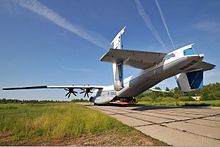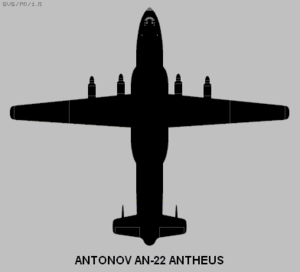Antonov An-22
| An-22 "Antei" | |
|---|---|

| |
| Antonov An-22 | |
| Role | Strategic airlifter |
| National origin | Soviet Union |
| Manufacturer | Antonov |
| First flight | 27 February 1965 |
| Introduction | 1967 |
| Status | In limited service |
| Primary users | Russian Aerospace Forces Aeroflot Antonov Airlines |
| Produced | 1966–1976 |
| Number built | 68 |
The Antonov An-22 "Antei" (Russian: Ан-22 Антей,[1] An-22 Antej; English Antaeus) (NATO reporting name "Cock") is a heavy military transport aircraft designed by the Antonov Design Bureau in the Soviet Union. Powered by four turboprop engines each driving a pair of contra-rotating propellers, the design was the first wide-body transport aircraft and remains the world's largest turboprop-powered aircraft to date. The An-22 first appeared publicly outside the Soviet Union at the 1965 Paris Air Show. Thereafter, the model saw extensive use in major military and humanitarian airlifts for the Soviet Union, and is still in service with the Russian Aerospace Forces.
Design and development


In the late 1950s, the Soviet Union required a large military transport aircraft to supplement the
The aircraft was designed as a
It has the capability to takeoff from austere, unpaved, and short airstrips, allowing airborne troops to perform
The An-22 follows traditional cargo transport design with a high-mounted wing allowing a large cargo space of 33 m in length and a usable volume of 639 m³. The forward fuselage is fully pressurized and provides space for 5 to 8 crew and up to 28 passengers, but the cargo space is pressurized to only 3.55 PSI / 0.245 bar allowing for a lighter airframe. A door equipped with pressure bulkhead is located at frame 14, separating the cargo attendant's compartment from the main cargo compartment. This allows the rear cargo doors to be opened during flight for paratroops and equipment drop. Like the An-12, the aircraft has a circular fuselage section. The An-22 has set a number of payload and payload-to-height world records.[citation needed]
The An-22 has the general appearance of an enlarged version of the earlier Antonov An-12 except that it is fitted with a twin tail. This gives the An-22 better engine-out performance, and reduces height restrictions for hangars. Also of note are large anti-flutter masses on the top of each tail.
Only one production variant was built, the standard An-22.[clarification needed] Prototypes, such as the one first featured at the 1965 Paris Air Show had fully glazed noses that lacked the nose-mounted radar of production models. Those aircraft had the radar mounted below the right wheel well fairing, forward of the wheels. Antonov designated a variant with a modified electrical system and an additional augmented flight control system the An-22A but the designation was not used by the military.[2]
A proposed civil airliner version capable of seating 724 passengers on upper and lower decks was planned but wasn't constructed. (For comparison, a typical Boeing 747 can carry 400–500 passengers.)
Total production
| Total Production[3] | 1975 | 1974 | 1973 | 1972 | 1971 | 1970 | 1969 | 1968 | 1967 | 1966 | 1965 | 1964 | 1963 |
|---|---|---|---|---|---|---|---|---|---|---|---|---|---|
| 68 | 12 | 9 | 9 | 8 | 8 | 7 | 7 | 1 | 1 | 4 | 1 | 0 | 1 |
Variants


- An-22
- Three original prototypes were built at the Antonov facility in Kyiv, with glass nose.
- Amphibious An-22
- An amphibian version of the An-22 was proposed, but did not progress past the scale model phase.
- An-22
- Initial production variant with external start system, 37 built at Tashkent.
- An-22A
- Improved variant with air-start capability, modified electrical system, and updated radio and navigation equipment, 28 built at Tashkent.
- An-22PZ
- Conversion of two An-22s to carry wing centre sections or outer wings of Antonov An-124 or An-225 externally above fuselage. Fitted with third centreline fin.[4]
Several other An-22 variants were projected and constructed by Antonov but never entered serial production, notably a
Operational history
The An-22 was originally built for the
An early use of the An-22 was to deliver Soviet humanitarian aid to Peru in July 1970 following the Ancash earthquake. One An-22 disappeared on 18 July during these relief flights. An-22s were also used to deliver Soviet military aid to Egypt and Syria during the Yom Kippur War in 1973, to Angola in 1975, and to Ethiopia in 1977.[5]
The An-22s from Migalovo were used for the initial deployment of the
In 1984, military An-22s were used to deliver Mi-8 helicopters to Ethiopia during drought relief operations.
In 1986 the aircraft of the 8th Military Air Transport Aviation Regiment from Migalovo were used to deliver materials for the Chernobyl disaster relief operation.
During 1987 the An-22s were used to deliver military equipment to Angola. A year later the military An-22s were used to deliver 15,000 tons and 1,000 personnel for the 1988 Armenian earthquake relief operation.

The An-22 aircraft were often seen at the
In late 1980s, the An-22s were used to deliver
Approximately 45 An-22s remained in service by the mid-1990s, mostly with the
As of December 2018, six An-22s were in service with the 76th Military Transport Air Squadron at Tver, with only three aircraft airworthy. They are planned to remain in service until 2033.[7]
A single An-22 (registration number UR-09307) is in service with Antonov Airlines as of September 26, 2020 but was potentially damaged in 2022 during Russia's military action in Ukraine.[8]
Operators

Military
Current
- Russian Aerospace Forces 3 active
Former
- Soviet Air Force.
- 8th Military Transport Aviation Regiment[9]
- Other regiments
Civil

Current
- 2022 Russian invasion of Ukraine at the Battle of Antonov Airport on February 24, 2022, the aircraft reportedly suffered substantial damage when penetrated by projectiles. [10]
Former
- Air Sofia (leased)
Incidents and accidents
As of January 2011, there have been 9 hull losses with a total of 95 fatalities.[citation needed]
| Date | Registration | Location | Fatalities | Brief description |
|---|---|---|---|---|
| 18 July 1970 | СССР-09303 | The Atlantic Ocean near Keflavík International Airport, Iceland | All of 7 passengers + 15 crew | Was transporting humanitarian aid to Lima, Peru.
Radar contact was lost 47 minutes after takeoff from Keflavík International Airport.[11] |
| 28 December 2010 | RA-09343 | Near Krasny Oktyabr (Tula Oblast, Russia) | All 12 crew
(no passengers) |
RA-09343 of the |
Specifications (An-22)

Data from Jane's all the world's aircraft, 1991–92[15]
General characteristics
- Crew: 5–6
- Capacity: 28–29 pax / 80,000 kg (176,370 lb) maximum payload
- Length: 57.92 m (190 ft 0 in) approx (dependent on nose config.)
- Wingspan: 64.4 m (211 ft 3 in)
- Height: 12.53 m (41 ft 1 in)
- Wing area: 345 m2 (3,710 sq ft)
- Airfoil: root:TsAGI S-5-16 ; tip: TsAGI S-5-13[16]
- Empty weight: 114,000 kg (251,327 lb)
- Max takeoff weight: 250,000 kg (551,156 lb)
- Fuel capacity: 43,000 kg (94,799 lb) maximum
- Powerplant: 4 × Kuznetsov NK-12MA turbopropengines, 11,000 kW (15,000 shp) each (equivalent)
- Propellers: 8-bladed contra-rotating constant-speed reversible-pitch propeller
Performance
- Maximum speed: 740 km/h (460 mph, 400 kn)
- Range: 5,000 km (3,100 mi, 2,700 nmi) with maximum payload
- 10,950 km (6,800 mi; 5,910 nmi) with maximum fuel and 45,000 kg (99,208 lb) payload
- Wing loading: 724.6 kg/m2 (148.4 lb/sq ft) max
- Power/mass: 0.1789 kW/kg (0.1088 hp/lb) max
- Take-off run: 1,300 m (4,265 ft)
- Landing run: 800 m (2,625 ft)
On display
A former Ukrainian Air Force AN-22 is on display at the
See also
Related development
- Antonov An-12 – Soviet medium-range transport aircraft
Aircraft of comparable role, configuration, and era
- Douglas C-133 Cargomaster – US heavy lift four engine turboprop military aircraft, 1956
- Boeing C-17 Globemaster III – American four engine military transport aircraft
- Ilyushin Il-76 – Russian heavy military transport aircraft
- Xi'an Y-20 – Chinese military transport aircraft
- Airbus A400M Atlas – Multi-national four-engine turboprop military transport aircraft
- Short Belfast-British military transport aircraft
Related lists
References
- ^ named for the mythical Greek half-giant
- ^ ISSN 1465-6337.
- ^ "✈ russianplanes.net ✈ наша авиация". russianplanes.net. Archived from the original on 25 August 2018. Retrieved 9 February 2019.
- ^ Gordon, Komissarov and Komissarov Air International January 2006, pp. 35–36.
- ^ Gordon, Komissarov and Komissarov Air International January 2006, pp. 36–37.
- ^ Gordon, Komissarov and Komissarov Air International January 2006, p. 37.
- ISSN 0306-5634.
- ^ "АЭРОПОРТ ГОСТОМЕЛЬ. Здесь был "русский мир"". YouTube.
- ^ "8th Military-Transport Aviation Regiment". Archived from the original on 12 February 2013. Retrieved 28 September 2017.
- ^ "ASN Aircraft accident Antonov An-22A UR-09307 Kyiv-Gostomel Airport (GML)".
- ^ "Антонов АН-22 Антей". www.airwar.ru. Archived from the original on 9 February 2019. Retrieved 9 February 2019.
- ^ "RA09343 Accident description". Aviation Safety Network. Archived from the original on 25 June 2011. Retrieved 1 January 2011.
- ^ "Антонов Ан-22А Бортовой №: RA-09343" (in Russian). Russian Planes. Archived from the original on 23 January 2011. Retrieved 1 January 2011.
- ^ "Giant Antonov An-22 cargo plane crashes in rural Russia". BBC News. 29 December 2010. Archived from the original on 26 January 2011. Retrieved 28 December 2010.
- OCLC 1035932568. Retrieved 12 September 2019.
- ^ Lednicer, David. "The Incomplete Guide to Airfoil Usage". m-selig.ae.illinois.edu. Retrieved 16 April 2019.
- Alexander, Jean (1975). Russian Aircraft since 1910. London: Purnell Book Services.
- Gordon, Yefim; Komissarov, Dmitry; Komissarov, Sergei. "Antonov An-22: A Venerable Giant". Air International. No. January 2006. pp. 30–37.
- ISBN 1-85532-405-9.
- Stroud, John (1968). Soviet Transport Aircraft since 1945. London: Putnam. ISBN 0-370-00126-5.
Further reading
- Pyotr Butowski, 'Air Power Analysis – Russian Federation Part 2' in International Air Power Review, Volume 13, Summer 2004, AIRtime Publishing Inc., Norwalk, CT.
- Goebel, Greg (1 January 2006). "The Antonov Giants". Air Vectors. Archived from the original on 12 August 2006. Retrieved 28 June 2006.
- "Antonov An-22 Antheus". airliners.net. Archived from the original on 18 June 2006. Retrieved 28 June 2006.
